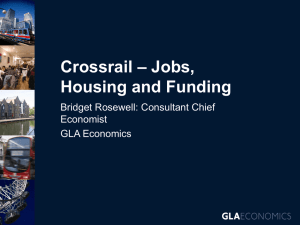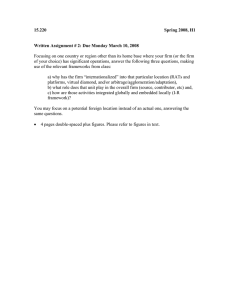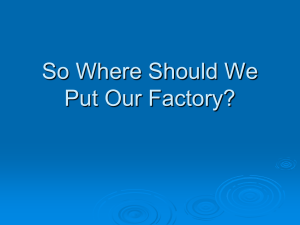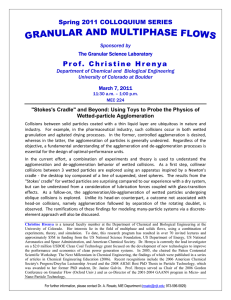Can we fund Crossrail? Stephen Glaister Professor of Transport and Infrastructure
advertisement
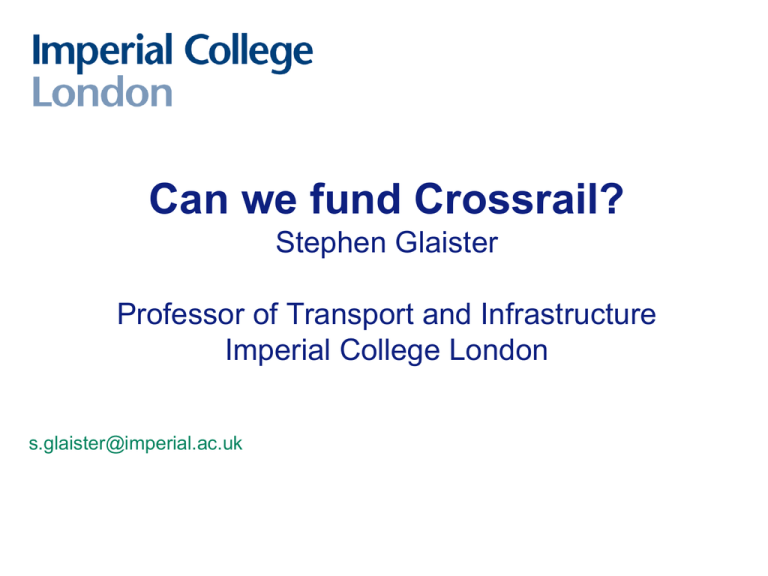
Can we fund Crossrail? Stephen Glaister Professor of Transport and Infrastructure Imperial College London s.glaister@imperial.ac.uk The Scheme now in Parliament 2 3 Capital cost £16 billion outturn, nominal, not discounted. Excludes rolling stock maintenance and renewals 4 Funding proposal £ billion 5 DfT (central government) grant 5 GLA borrowing funded by business rate supp. 3.5 TfL borrowing funded by new fare revenue 2.7 Network Rail funded by track access charges 2.3 Land sales, developer contributions, private sector contributions, savings Metronet being managed in-house 2.5 The Jubilee Line Story 1975 Jubilee Line to Charring Cross nearly completed LT await final funding approval for “Fleet Line” 1985 Olympia & York start Canary Wharf 1987 O&Y offer to build own shuttle: Waterloo-CW 1989 Central London Rail Study: Joint Gvt, BR, LT into solutions for rail congestion 6 The Fleet Line 7 1989 Government “GO AHEAD” for Crossrail AND Chelsea Hackney Line Crossrail cost £1 bn; benefit:cost = 1.3 Crossrail to be a large bore underground to allow high speed access to the centre from West and East 8 No action Later in 1989 Government “GO AHEAD” for Jubilee Line Extension JLE cost £1 bn - £400m contribution from O&Y benefit:cost = 0.95 9 Early 1990s London economy goes into recession Gvt. “if it’s worthwhile then the private sector will fund it” (!) 1994 Crossrail Bill fails in Parliament for lack of funding Nb. To date we have spent well over £500m planning Crossrail. At 5% pa, the interest on £500m is £70,000 10 2000 Creation of Greater London Authority Mayor Ken Livingstone Chairs Transport for London, the delivery executive Funding almost entirely in the gift of HMT Government unable or unwilling to fund Crossrail “Business must get out its cheque book” 11 Montague Review 2003 Note that two new arms have sprouted! A link to Richmond (this did not survive) A link to serve Canary Wharf 12 Why do we still need Crossrail? 13 London population and employment 14 Location of employment growth 15 Location of population growth 16 Crossrail is an essential part of the rail solution 17 18 Wider Economic Benefits Since 1989 Government has felt that there is a case for Crossrail But conventional economic appraisal could not demonstrate sufficient benefits Development of appraisal of “wider economic benefits” Eddington Report (December 2006) recommends routine adoption in appraisal Dan Graham, “Agglomeration, Productivity and Transport Investment”, J. Transport Economics & Policy, September 2007 19 Transport and agglomeration economies Agglomeration economies – positive externalities that derive from spatial concentration – e.g. knowledge / technology sharing, specialization, labour market pooling, increase in market scale, sharing markets for inputs and outputs etc. Transport / generalised costs of travel are crucial to agglomeration: – – – transport (costs) in part determines economic densities: accessibility transport constraints can inhibit agglomeration economies new investment changes the density or concentration of activity (including labour) accessible to firms Agglomeration is an externality / market imperfection it is not captured in a standard appraisal. 20 Measurement and estimation of agglomeration To evaluate agglomeration benefits we need estimates of elasticities of productivity w.r.t agglomeration i. Construct a national database of information about the productivity of firms across all economic sectors. ii. Locate firms geographically in a GIS. iii. Construct measures of the agglomeration ‘experienced’ by each firm in each location - compatible with use in transport appraisal. 21 Measurement and estimation of agglomeration iv. The total effective density that is accessible to any firm located in area i is U j EDi j d ij i j where U is some measure of activity (i.e. employment or population) and dij is the distance between areas i and j. – – – – v. 22 captures scale and proximity highly flexible spatial framework incorporates an implicit transport accessibility dimension replace distance with travel times, generalized costs etc. Estimation using the translog system – allows a flexible comprehensive model of production. Results – agglomeration elasticities industry 23 elasticity Manufacturing 0.077 Construction 0.072 Distribution, hotels & catering 0.153 Trans, storage& communications 0.223 Real estate 0.192 IT 0.082 Banking, finance & insurance 0.237 Business services 0.224 Whole economy 0.119 Results - 1 • Positive and significant impact from urban density for most but not all sectors of the economy • The magnitude of the agglomeration elasticity varies substantially across industries • No agglomeration economies for primary industries • Mixed evidence for manufacturing industries about the effect and strength of agglomeration economies • Average manufacturing elasticity of 0.077 – compares reasonably well to previous estimates. 24 Results - 2 • Positive and significant agglomeration elasticities for most service industries. • An increase of 20% in service sector productivity with a doubling of city size – 24% for Financial services – 22% for Business services 25 Applying the new appraisal to CrossRail (DfT calculations) Benefits 26 Welfare (£ million) Business time savings 4,847 Commuting time savings 4,152 Leisure time savings 3,833 Total user benefits (conventional) 12,832 Agglomeration benefits 2,440 Total benefits (inc agglom) 15,272 Most recent published estimates costs & benefits 27 28 29 Funding proposal 30 It can be funded… but… £ billion DfT (central government) grant 5 GLA borrowing funded by business rate supp. 3.5 TfL borrowing funded by new fare revenue 2.7 Network Rail funded by track access charges 2.3 Land sales, developer contributions, private sector contributions, savings Metronet being managed in-house 2.5 31 The problems of delivery Need primary legislation for Business Rate Supplement TfL will have to increase its borrowing Some items of income are vague Some items of expenditure may be unspecified rolling stock, operations, maintenance 32 The problems of delivery Project Governance – who’s project? TfL, DfT, Network Rail…? Cross London Links Ltd. Who bears the financial risks? How to procure? 33 JLE what went wrong? JLE estimated at £1 bn, outturn over £4 bn. Gvt. insisted on unrealistic cost estimates Omitted important items Imposed absolute deadline for Millennium celebrations Tunnelling costs WERE accurate. 34 ARUP reporting as SoS’s Agent 35 Managing the project 4,000 3,500 3,000 2,500 2,000 1,500 1,000 500 0 2006 36 2007 2008 2009 2010 2011 2012 2013 2014 2015 2016 2017 2018 But what about contruction cost inflation? 37 Interface Risks London Underground PPP PFI contracts for ticketing, communications, power Olympics Network Rail Thameslink East London Line Thames Tideway 38 Interaction with London on the surface 39 40 Implications for TfL’s capacity to do other things? 41 42
